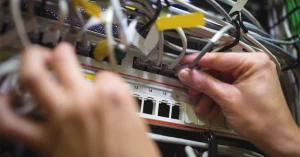In today’s digital age, protecting sensitive information, especially passport data, is crucial. IT network troubleshooting is the key to ensuring the security and integrity of this data.
This article explores the importance of IT network error resolution in safeguarding passport information, addressing the challenges and risks that arise when network issues are not promptly resolved.
It also highlights effective strategies and best practices for efficient network troubleshooting, enabling organizations to proactively protect individuals’ personal data.
Key Takeaways
- Networking Issue Diagnostics is crucial for safeguarding sensitive passport information.
- It ensures the smooth functioning of passport systems and minimizes downtime.
- Troubleshooters address network connectivity issues, security breaches, performance degradation, and compatibility problems.
- Best practices include establishing standardized documentation, conducting regular audits, implementing monitoring systems, and using diagnostic tools.
The Importance of IT Network Troubleshoot
The importance of IT network troubleshoot lies in its ability to safeguard sensitive passport information. In today’s digital age, passports contain a multitude of personal and confidential data, including biometric information and travel history. Any breach in the IT network can lead to the unauthorized access and misuse of this information, posing a significant threat to individuals and national security.
IT network Error Resolution plays a crucial role in identifying and resolving any issues that may compromise the security and integrity of passport data. By constantly monitoring the network infrastructure, troubleshooting professionals can detect and mitigate potential vulnerabilities, ensuring that the passport information remains secure. This involves analyzing network traffic, identifying potential threats, and implementing effective security measures.
Moreover, Networking Issue Diagnostics helps in maintaining the smooth functioning of passport systems. By proactively addressing network issues, troubleshooting professionals can minimize downtime and ensure that passport services operate efficiently. This, in turn, enhances customer satisfaction and instills confidence in the reliability of passport services.
Common Challenges in IT Network Troubleshooting
Identifying and overcoming common challenges is essential in effective IT network troubleshooting. When troubleshooting IT networks, professionals often encounter various issues that can hinder the resolution process. Understanding these challenges is crucial for successfully resolving network problems and maintaining a secure and reliable network infrastructure.
Here are four common challenges in IT network troubleshooting:
- Network Connectivity Issues: Problems with network connectivity can arise due to faulty hardware, misconfigured network settings, or network congestion. Troubleshooters need to diagnose and resolve these issues to ensure uninterrupted network access.
- Security Breaches: Network security breaches can compromise sensitive data and disrupt network operations. Troubleshooters must identify vulnerabilities, implement robust security measures, and respond promptly to any security incidents.
- Performance Degradation: Slow network performance can impact productivity and user experience. Troubleshooters must identify the root cause of performance degradation, such as bandwidth limitations or network congestion, and optimize the network accordingly.
- Compatibility Problems: Incompatibilities between different network components or software versions can lead to network issues. Troubleshooters need to ensure compatibility and update or replace incompatible components to maintain a functional network.
Best Practices for IT Network Troubleshoot
To ensure efficient troubleshooting of IT networks, it is essential to implement a set of best practices. These practices are designed to streamline the process, minimize downtime, and protect sensitive information, such as passport data.
One important best practice is to establish a standardized network documentation system. This documentation should include detailed information about the network infrastructure, configurations, and any changes that have been made. Having this information readily available can greatly expedite the troubleshooting process.

Additionally, regular network audits should be conducted to identify any vulnerabilities or potential issues before they become major problems. This includes reviewing firewall configurations, monitoring network traffic, and ensuring that all devices are up to date with the latest security patches.
Tools and Technologies for Effective Networking Issue Diagnostics
One essential tool for effective IT network Error Resolution is a comprehensive network monitoring system. This tool allows network administrators to monitor the performance and health of the network in real-time, identify potential issues, and proactively resolve them before they impact users.
In addition to a network monitoring system, there are several other tools and technologies that can aid in Networking Issue Diagnostics:
- Packet analyzers: These tools capture and analyze network traffic, providing valuable insights into the behavior of the network and helping to identify the root cause of any issues.
- Network diagnostic tools: These tools can help diagnose and troubleshoot network connectivity problems, such as issues with IP addresses, DNS resolution, or network configuration.
- Performance testing tools: These tools simulate network traffic and measure the performance of the network under different conditions, allowing administrators to identify any bottlenecks or areas for improvement.
- Configuration management tools: These tools help administrators manage and track network configurations, ensuring consistency and reducing the risk of configuration errors.
Proactive Measures to Protect Passport Information
To ensure the security of passport information, it is crucial to implement proactive measures. With the increasing sophistication of cyber threats, organizations must take steps to protect sensitive data from unauthorized access.
One of the most effective proactive measures is implementing a robust network security framework. This includes deploying firewalls, intrusion detection systems, and secure network protocols to safeguard against potential attacks. Additionally, regular vulnerability assessments and penetration testing can identify and address any weaknesses in the network infrastructure.
Implementing strong access controls and authentication mechanisms, such as multi-factor authentication, can further enhance the security of passport information. Furthermore, continuous monitoring and logging of network activities can help detect any suspicious behavior and enable prompt response to potential security incidents.
Case Studies: Successful IT Network Troubleshooting Practices
Successful IT network troubleshooting practices have been instrumental in addressing and resolving complex issues within organizational networks. These case studies highlight the effectiveness of these practices in ensuring the smooth functioning of IT networks and protecting sensitive information such as passport data.
- Comprehensive Network Monitoring: Implementing network monitoring tools and technologies allows for real-time monitoring of network performance, identifying potential issues before they escalate into major problems.
- Thorough Network Documentation: Maintaining up-to-date documentation of network configurations, device settings, and network topology provides a reference point for troubleshooting and enables faster resolution of issues.
- Effective Incident Response Plan: Having a well-defined incident response plan in place ensures a systematic and efficient approach to troubleshooting network problems, minimizing downtime and impact on operations.
- Regular Network Audits: Conducting regular audits helps to identify vulnerabilities and weaknesses in the network infrastructure, allowing for proactive troubleshooting and security enhancements.
Frequently Asked Questions
How Does IT Network Troubleshooting Help in Protecting Passport Information?
IT network troubleshooting plays a crucial role in protecting passport information. By identifying and resolving network issues, it ensures that data transmission is secure and uninterrupted.
Troubleshooting helps in detecting any vulnerabilities or potential threats in the network infrastructure, allowing for timely patching and reinforcement of security measures.
Moreover, it helps in monitoring network traffic and identifying any suspicious activities that could indicate unauthorized access attempts.
What Are Some Common Challenges Faced in IT Network Troubleshooting?
In the realm of IT network troubleshooting, there are several common challenges that professionals may encounter. These challenges include:
- Identifying and resolving connectivity issues
- Ensuring network security and data protection
- Troubleshooting hardware and software problems
- Managing network performance
Additionally, network troubleshooting often involves working with complex systems and technologies, requiring a deep understanding of network protocols and configurations.
Successfully navigating these challenges is crucial for safeguarding sensitive information, such as passport data, and ensuring the smooth functioning of an organization’s IT infrastructure.
Are There Any Best Practices to Follow for Effective Networking Issue Diagnostics?
Yes, there are several best practices to follow for effective Networking Issue Diagnostics.
Firstly, having a thorough understanding of the network infrastructure is crucial. This includes knowing the hardware and software components, network protocols, and security measures in place.
Additionally, documenting network configurations and maintaining an up-to-date inventory of network devices can greatly assist in troubleshooting.
Regular network monitoring and proactive maintenance also play a significant role in identifying and resolving issues before they escalate.
Lastly, having a well-trained and knowledgeable IT support team is essential for efficient troubleshooting.
What Tools and Technologies Are Commonly Used in IT Network Troubleshooting?
Commonly used tools and technologies in IT network troubleshooting include:
- Network analyzers: These tools help identify and analyze network traffic.
- Packet sniffers: Packet sniffers capture and analyze data packets.
- Monitoring software: This software provides real-time monitoring of network performance and identifies potential issues.
These tools enable IT professionals to diagnose and resolve network problems efficiently. By doing so, they ensure the smooth functioning of IT networks and protect sensitive information, such as passport data.
What Proactive Measures Can Be Taken to Protect Passport Information?
To protect passport information, proactive measures can be taken to ensure the security of the IT network. This includes:
- Implementing strong firewalls
- Regularly updating software and security patches
- Conducting regular network audits
- Enforcing strict access controls and user authentication protocols
- Implementing encryption techniques for data transmission
- Implementing intrusion detection and prevention systems
Additionally, regular employee training on cybersecurity best practices and awareness can help mitigate the risk of data breaches and unauthorized access to passport information.
Conclusion
In conclusion, effective IT network troubleshooting is crucial for safeguarding passport information in today’s digital age. By promptly identifying and resolving network issues, organizations can ensure the integrity and security of sensitive data.
However, this process comes with its own challenges, which can be overcome through the use of best practices and appropriate tools and technologies.
By adopting proactive measures and learning from successful case studies, organizations can proactively protect passport information and uphold individuals’ privacy and security.
You May Also Like:





